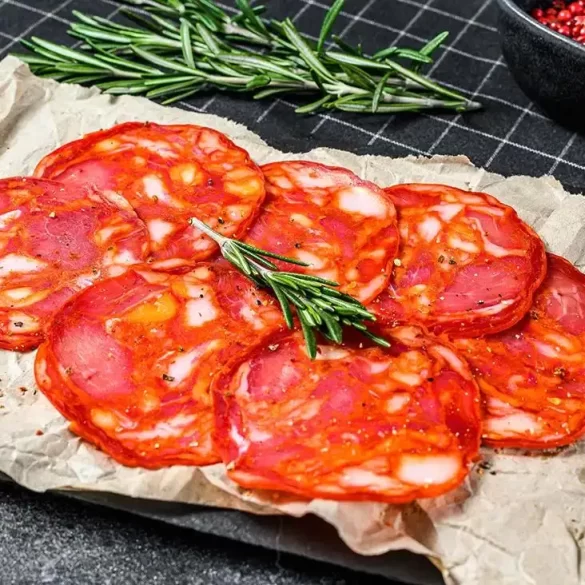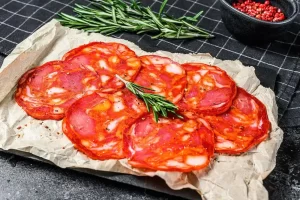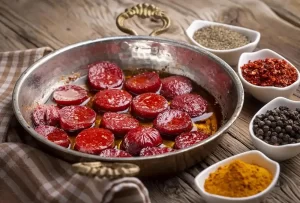Table of Contents
Hot Soppressata is a traditional Italian cured meat, originating from the southern regions of Italy, particularly Calabria, Basilicata, and Apulia. Known for its unique, coarse texture and distinct flavor profile, soppressata stands out among Italian salamis for its bold, rustic quality and occasional spiciness.
While many cured meats are finely ground, soppressata is coarsely chopped, giving it a chunky, uneven texture that distinguishes it from smoother salamis. This texture results from the traditional method of mincing the pork by hand, which preserves the meat’s natural juiciness and ensures a hearty, satisfying bite. Additionally, the use of pork shoulder and added fat gives soppressata its rich, flavorful base.
Authentic soppressata is usually spiced with black pepper, garlic, and fennel seeds, though hot versions incorporate red pepper flakes for a spicy twist. The meat is then encased in natural hog casings and left to cure, traditionally in cool cellars, for weeks. During the drying process, the flavors deepen and develop, resulting in a complex profile with smoky, savory, and sometimes mildly spicy notes.
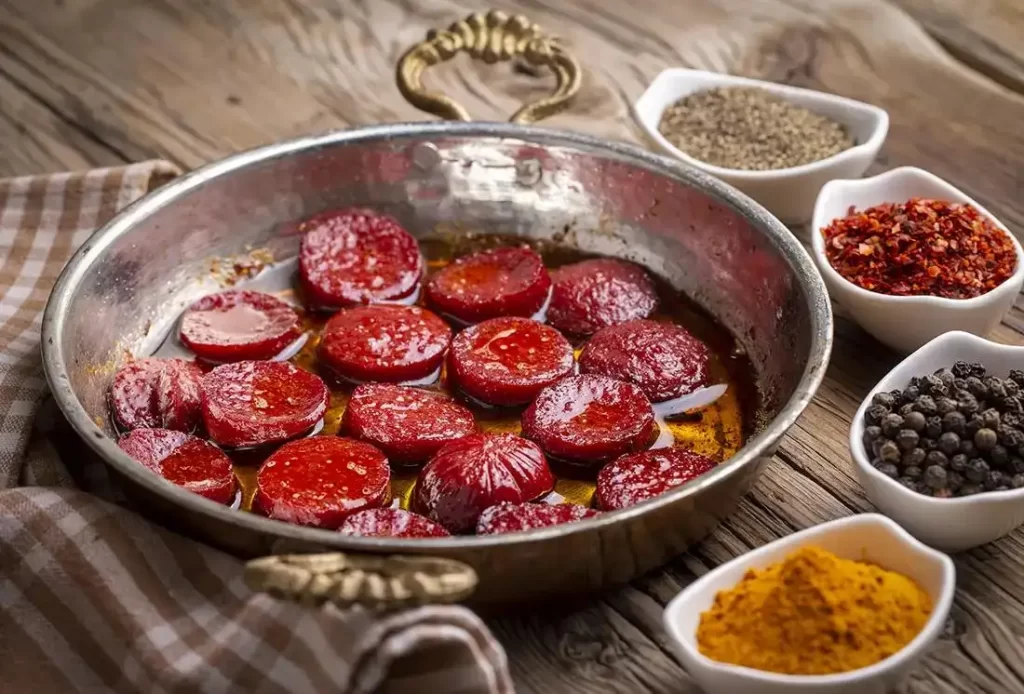
How to make Hot Soppressata
Hot Soppressata is incredibly versatile. While it’s perfect for enjoying on its own, many also love adding it as a topping on soppressata pizza, mixing it into pasta dishes, or pairing it with cheeses on charcuterie boards. Its bold flavor can elevate a range of dishes, bringing a taste of Italy to any meal.
Ingredients to make Hot Soppressata
To make a traditional hot soppressata, it’s crucial to choose the right ingredients for an authentic taste and texture.
- Pork Shoulder – 2 pounds (preferably from heritage pork for optimal flavor)
- Pork Fat – ½ pound, finely diced
- Salt – 1 tablespoon
- Freshly Ground Black Pepper – 1 teaspoon
- Crushed Red Pepper Flakes – 1 tablespoon (adjust to taste for spiciness)
- Paprika – 1 tablespoon
- Garlic – 3 cloves, finely minced
- Fennel Seeds – 1 teaspoon (optional for a hint of anise flavor)
- Cure #2 (Sodium Nitrate) – ½ teaspoon (to ensure safe curing)
- Natural Hog Casings – about 3 feet, soaked and rinsed
Instructions to Make Hot Soppressata
Step 1: Preparing the Meat and Seasonings
- Start by chilling the pork shoulder and pork fat. This helps the meat and fat to grind more evenly and prevents smearing, which can affect the texture.
- Grind the meat and fat through a coarse grinder setting. If you don’t have a grinder, you can use a food processor, pulsing until you reach a coarse texture.
- In a large mixing bowl, combine the ground meat and fat with the salt, black pepper, red pepper flakes, paprika, garlic, fennel seeds, and Cure #2. Mix thoroughly to distribute the seasonings evenly. You can use your hands for this step, ensuring the flavors are well incorporated.
Step 2: Stuffing the Casings
- Prepare your natural hog casings by rinsing them in warm water and soaking them for at least 30 minutes. Fit your sausage stuffer with the casing, tying a knot at the end.
- Carefully stuff the meat mixture into the casing, working slowly to avoid air bubbles. Twist the casing at intervals to create smaller soppressata links, if desired.
- Once stuffed, tie the end securely and prick the casing with a sterilized needle to release any trapped air.
Step 3: Curing and Drying
- Hang the soppressata in a cool, dark place with good airflow. The ideal temperature for curing is between 55-65°F, with a humidity level around 70%.
- Allow the soppressata to cure for 4-6 weeks, checking regularly for texture and firmness. You’ll know it’s ready when the sausage feels firm to the touch.
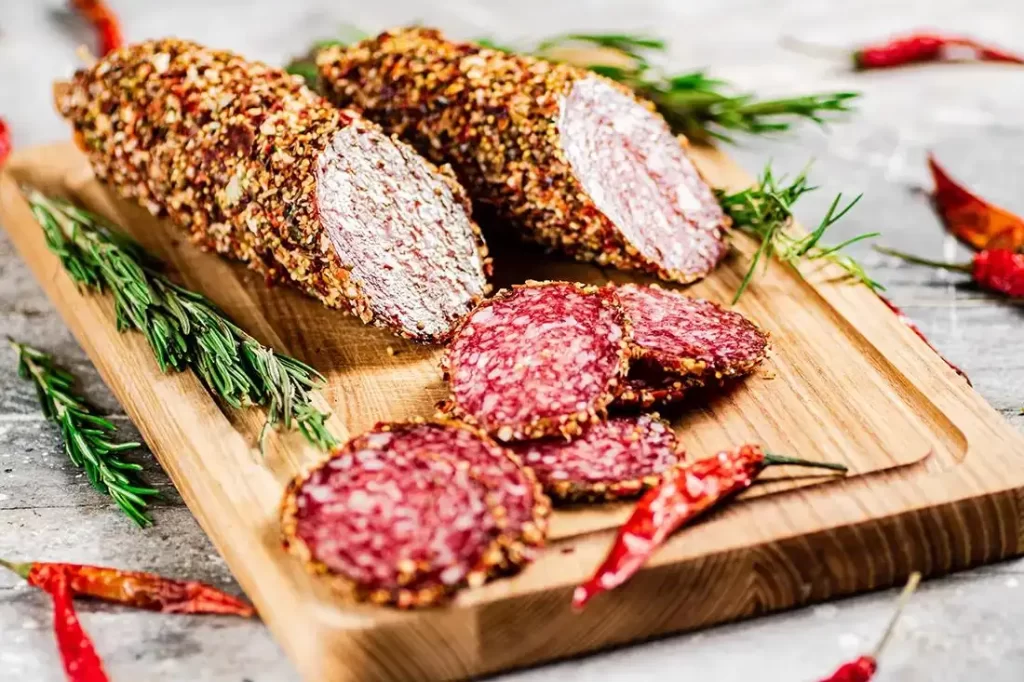
Tips for Making Hot Soppressata
- Choosing the Right Meat: Pork shoulder provides the ideal balance of meat and fat, essential for a flavorful soppressata.
- Sanitizing Equipment: Cleanliness is crucial for safe curing. Sanitize all surfaces, tools, and your hands before handling the meat.
- Patience is Key: Curing is a slow process, and rushing it can affect the taste and texture. Trust the process for the best results.
What to Serve with Hot Soppressata
Hot soppressata is versatile and pairs well with many side dishes, desserts, and drinks:
- Appetizers: Serve with marinated olives, crusty bread, and mild cheeses to balance the spicy flavors. For an Italian-inspired charcuterie board, pair hot soppressata with items like these unique Caffeinated Pizza Rolls for a flavor contrast
- Main Dish: Use it as a topping for soppressata pizza or add slices to a charcuterie board. Hot soppressata is fantastic as a pizza topping, adding a spicy twist to classics like Domino’s Viral Pizza.
- Dessert Pairing: Try serving it alongside Italian desserts like panna cotta or biscotti for a delightful contrast.
- Drinks: Pair with a dry red wine, such as Chianti or Barbera, to complement the spice and saltiness.
- For homemade pizza nights, try pairing soppressata with different crusts, like this classic Vito Iacopelli Pizza Dough, for a perfect balance of spicy and savory.

Variations of Soppressata
- Mild Soppressat: For a gentler flavor, reduce or omit the crushed red pepper flakes and use sweet paprika instead.
- Fennel Soppressat: Add extra fennel seeds to create a slight anise flavor, enhancing the traditional Italian taste.
- Garlic and Herb Soppressat: Include rosemary, thyme, or oregano for an aromatic twist on this classic.
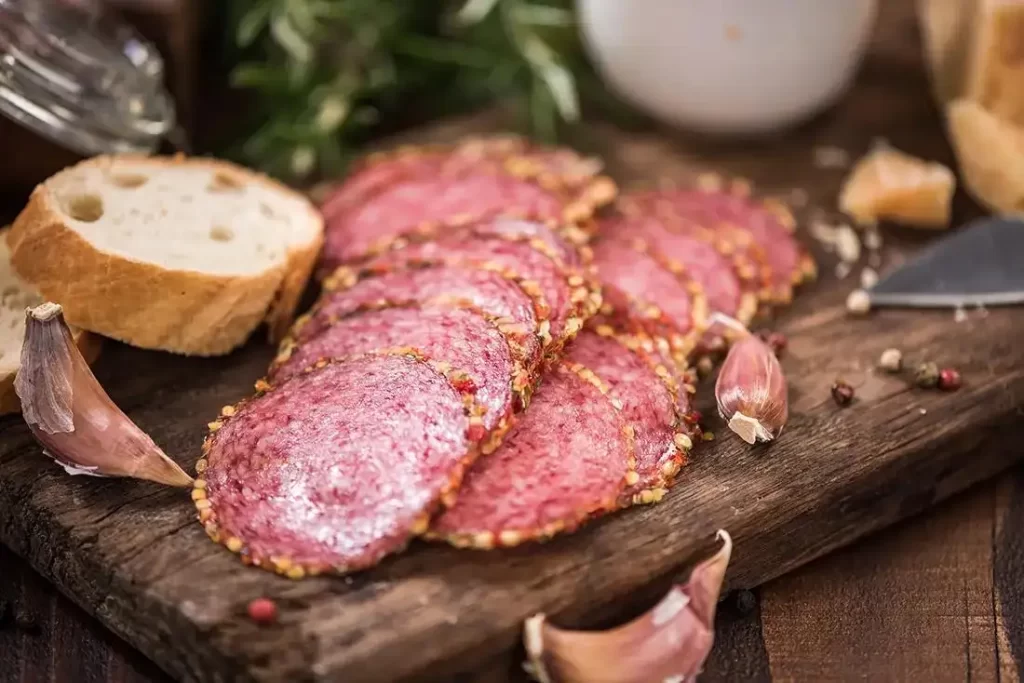
FAQs while making Hot Soppressata
How spicy is hot soppressata?
The spiciness can be adjusted based on the amount of crushed red pepper flakes. This recipe is moderately spicy, perfect for those who enjoy a kick without overwhelming heat.
Can I make soppressata without casing?
While traditional soppressata uses natural hog casings, you can form the mixture into rolls and wrap it in cheesecloth if you don’t have casings. However, this may impact the drying process.
What’s the difference between soppressata and salami?
Soppressata is a type of Italian salami but tends to have a coarser texture and a unique seasoning blend, often spicier and more robust than traditional salami.
Do I need special equipment to make soppressata?
While having a meat grinder and sausage stuffer can make the process easier, you can use a food processor for the meat and fat, and roll the mixture in cheesecloth if you don’t have casings. However, for authentic texture and flavor, traditional tools are recommended.
How long does homemade soppressata last?
Properly cured soppressata can last several months when stored in a cool, dry place. Once cut, wrap it tightly in parchment paper and store it in the fridge, where it should keep for up to three weeks.
Why is curing salt (Cure #2) necessary?
Curing salt (also called pink salt) contains sodium nitrate, which prevents harmful bacteria from developing during the long curing process. It’s crucial for safe, shelf-stable cured meats and should be used exactly as specified for best results.
What should I do if my soppressata has white mold on the casing?
White mold on the outside is typically a good sign and part of the natural curing process. It helps protect the meat from harmful bacteria. You can wipe it off with vinegar before serving. However, if you see green, black, or other colored molds, discard the soppressata, as this may indicate spoilage.
Can I freeze soppressata?
Yes, you can freeze soppressata. Wrap it tightly in plastic wrap and store it in an airtight container. Frozen soppressata maintains its flavor for up to six months, though some texture changes may occur after thawing.
How do I know when my soppressata is fully cured?
Soppressata is typically ready when it feels firm to the touch and has lost about 30-40% of its initial weight. This usually takes 4-6 weeks, depending on temperature and humidity levels.
Can I adjust the spice level in hot soppressata?
Absolutely! If you prefer a milder soppressata, reduce the amount of crushed red pepper flakes. For extra heat, add more red pepper flakes or experiment with hot paprika for a smokier flavor.
What’s the best way to slice soppressata?
For the best texture, slice soppressata thinly with a sharp knife or a meat slicer if you have one. Thin slices enhance the flavor and make it easier to enjoy as part of a charcuterie board or as a pizza topping.
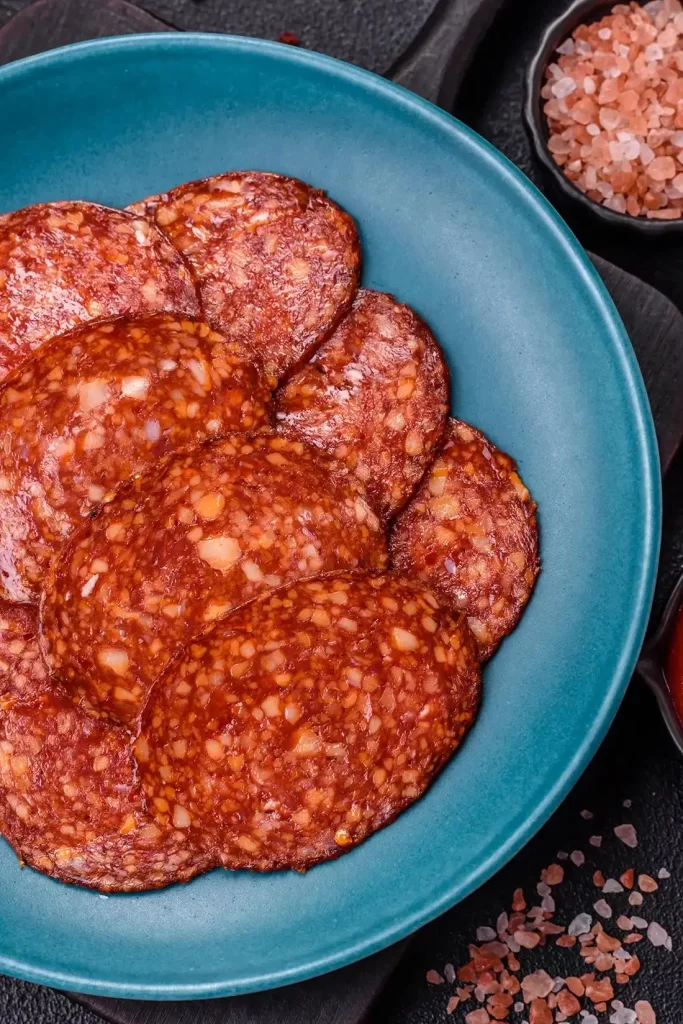
Substitutes
- Beef Instead of Pork: For a different flavor profile, use ground beef in place of pork.
- Vegetarian Version: Use smoked paprika, liquid smoke, and garlic with firm tofu for a plant-based option.
- Alternative Spices: Swap paprika with smoked paprika or cayenne for different levels of heat and flavor.
Nutrition Information (per 2-ounce serving)
- Calories: 180
- Protein: 12g
- Fat: 14g
- Carbohydrates: 1g
- Fiber: 0g
- Sugars: 0g
- Sodium: 500mg
Making hot soppressata at home brings an artisanal quality to your cooking, with a result that is perfect for everything from soppressata pizza to a spicy charcuterie board. With these detailed steps, you’ll be ready to prepare and serve this delicious Italian salami recipe at any gathering.



